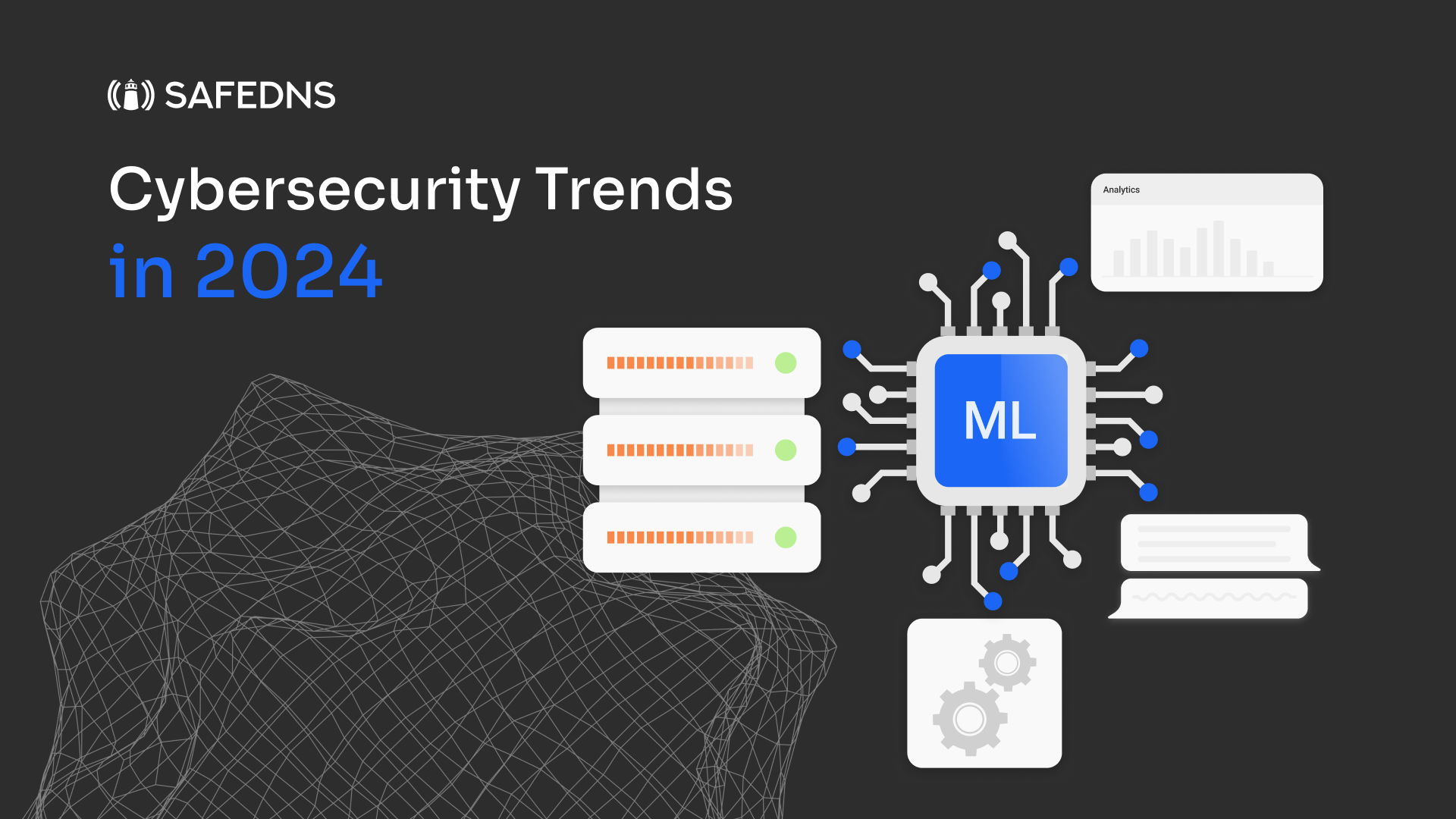
Cybersecurity Horizon: Trends for 2024
As we step into the realm of 2024, it is paramount to navigate the unfolding cybersecurity landscape, understanding the emerging trends that will shape the digital defense strategies of both organizations and individuals in the months ahead. This article provides an overview of the key cybersecurity trends that everyone should be mindful of in 2024.
#1 Artificial Intelligence (AI) and Machine Learning (ML) in Cyber Attacks
The widespread use of Artificial Intelligence (AI) and Machine Learning (ML) by cyber attackers represents a substantial shift in the cybersecurity paradigm. These technologies empower malicious actors to craft more adaptive and nuanced threats, challenging the effectiveness of traditional cyber security measures.
In response, cybersecurity professionals are harnessing the power of AI for defensive purposes. The emphasis lies in developing advanced threat detection and prevention engines that leverage machine learning algorithms to identify anomalies, predict potential insider threats, and automate responses. This proactive approach aims to outmaneuver cybercriminals by staying ahead of the evolving tactics they employ.
As the deployment of AI in the cybersecurity sector matures, it brings forth not only opportunities but also ethical considerations. The industry is grappling with issues such as bias in AI algorithms, the explainability of AI-driven decisions, and the potential misuse of AI for offensive purposes. Addressing these challenges is integral to ensuring the responsible and effective integration of AI into cybersecurity practices.
#2 Credential Theft Through Phishing
The evolution of work models and digital data, driven by the remote and hybrid workforce trends, has led to a significant uptick in cyberattacks targeting user passwords and credentials. Credential theft and data breaches, particularly through phishing, have become an unfortunate reality in our digital landscape. To counteract this trend, organizations must fortify their defenses with robust security measures.
Implementing a stricter password policy, advocating for the use of password managers, and enabling multi-factor authentication wherever possible are essential steps in safeguarding against credential theft. Moreover, protecting privileged accounts through access control protocols and fostering employee education on cyber threats are crucial components of a comprehensive defense strategy. Content filtering solutions that prevent users from clicking on untrusted links or being directed to malicious resources add an extra layer of protection against the insidious threat of credential and identity theft.
#3 Zero-Trust Architecture
The concept of Zero-Trust Architecture has gained significant popularity, challenging the conventional security model that relies on perimeter-based defenses. In a Zero Trust environment, trust is never assumed, and everyone attempting to gain access to resources must undergo verification, irrespective of their location or network connection.
Organizations are increasingly embracing Zero-Trust principles to enhance their security posture. This involves continuous verification, least-privilege access, and dynamic access control. By implementing stricter access policies, enterprises aim to minimize the risk of unauthorized access and lateral movement within networks, providing a more resilient defense against sophisticated cyber threats.
The adoption of Zero-Trust Architecture also requires a cultural shift within organizations. It necessitates a move from the traditional mindset of trusting entities within the network perimeter to a more vigilant approach where trust is established through continuous verification. This cultural shift is often as crucial as the technological aspects of implementing a Zero-Trust framework.
#4 Cloud Security Enhancements
As organizations continue to migrate to cloud environments, the focus on strengthening cloud security measures becomes paramount. Cloud services offer unparalleled flexibility and scalability, but they also present new challenges in terms of securing sensitive data stored and processed in the cloud.
Ensuring data integrity and confidentiality remains a top priority in cloud environments. Consequently, cloud security solutions are undergoing continuous enhancements to provide robust threat detection, encryption, and comprehensive access control. These measures are essential for safeguarding sensitive information, securing digital transactions, preventing unauthorized access, and mitigating the risks associated with cloud-based operations.
The evolution of cloud security also involves addressing concerns related to shared security infrastructure and responsibility models. While cloud service providers are responsible for the security of the cloud infrastructure, organizations must actively manage the security of their data and applications within the cloud. Understanding and implementing shared responsibility best practices are crucial for establishing a resilient and secure cloud environment.
#5 Internet of Things (IoT) Security Concerns
The proliferation of Internet of Things (IoT) devices presents a unique set of cybersecurity challenges. Insecure IoT devices can serve as potential entry points for cyberattacks, creating vulnerabilities within interconnected networks. The increasing number and variety of IoT devices further amplify security challenges and the complexity of securing these interconnected ecosystems.
Cybersecurity professionals are intensifying their efforts to enhance the security of IoT and mobile devices. This includes implementing strong authentication mechanisms, robust encryption protocols, and continuous monitoring to detect and mitigate potential IoT-related cyber threats. As the number of IoT devices continues to grow, the need for proactive security measures becomes increasingly apparent.
The evolving landscape of IoT security also demands collaboration among manufacturers, developers, and regulatory bodies. Establishing industry-wide standards and best practices for IoT security is essential to creating a more secure and resilient IoT ecosystem. Additionally, end-users play a crucial role in IoT security by ensuring that devices are regularly updated, configured securely, and integrated into networks with careful consideration for potential security risks.
#6 User Education and Awareness
Human error remains a significant factor in cybersecurity incidents, emphasizing the need for ongoing educational initiatives within organizations. Cybersecurity training for employees is not a one-time endeavor but a continuous process that evolves alongside emerging threats and technologies.
Educational efforts should focus on raising awareness about phishing attacks, promoting secure password practices, and instilling general cybersecurity hygiene. A well-informed user base serves as a critical line of defense against social engineering attacks and unintentional security lapses. Simulated phishing exercises, interactive training modules, and regular updates on the latest cyber threats contribute to creating a resilient and security-conscious organizational culture.
Moreover, organizations must foster a sense of responsibility among employees regarding their role in cybersecurity. Empowering individuals to recognize and report potential security incidents, emphasizing the importance of adhering to security policies, and promoting a culture of accountability contribute to building a robust human firewall against cyber threats.
#7 Collaborative Threat Intelligence
The landscape of cyber threats is increasingly interconnected, necessitating the need for collaborative efforts in sharing threat intelligence. Attackers employ cooperative strategies, and defenders must adopt a similar approach to stay ahead of evolving threats. Collaborative efforts significantly enhance cybersecurity measures and the collective ability to anticipate, detect, and respond to cyber threats effectively.
Information-sharing initiatives and partnerships are on the rise to facilitate the exchange of threat intelligence. Sharing insights about emerging threats, attack techniques, and vulnerabilities enables organizations to fortify their defenses proactively. Collaborative threat intelligence also plays a crucial role in the attribution of cyberattacks, aiding in the identification and apprehension of threat actors.
The collaborative approach to threat intelligence extends beyond organizational boundaries. Public-private partnerships, information-sharing platforms, and industry-specific alliances contribute to a more comprehensive and responsive cybersecurity ecosystem. As the cybersecurity community acknowledges the interconnected nature of threats, collaboration has become an integral component of a robust defense strategy.
In conclusion, the outlined trends underscore the critical importance of advanced technology, ongoing education, and collaborative efforts in navigating the dynamic landscape of cybersecurity in 2024. By staying informed about cybersecurity trends, embracing cutting-edge solutions, and fostering a culture of cybersecurity awareness, organizations and individuals can collectively strengthen their defenses and confidently confront the challenges of the digital age. As we live in a fast-paced digital reality, the proactive adoption of these trends will be instrumental in building a resilient defense against emerging cyber threats.
Take advantage of the SafeDNS trial period and try all the best features

